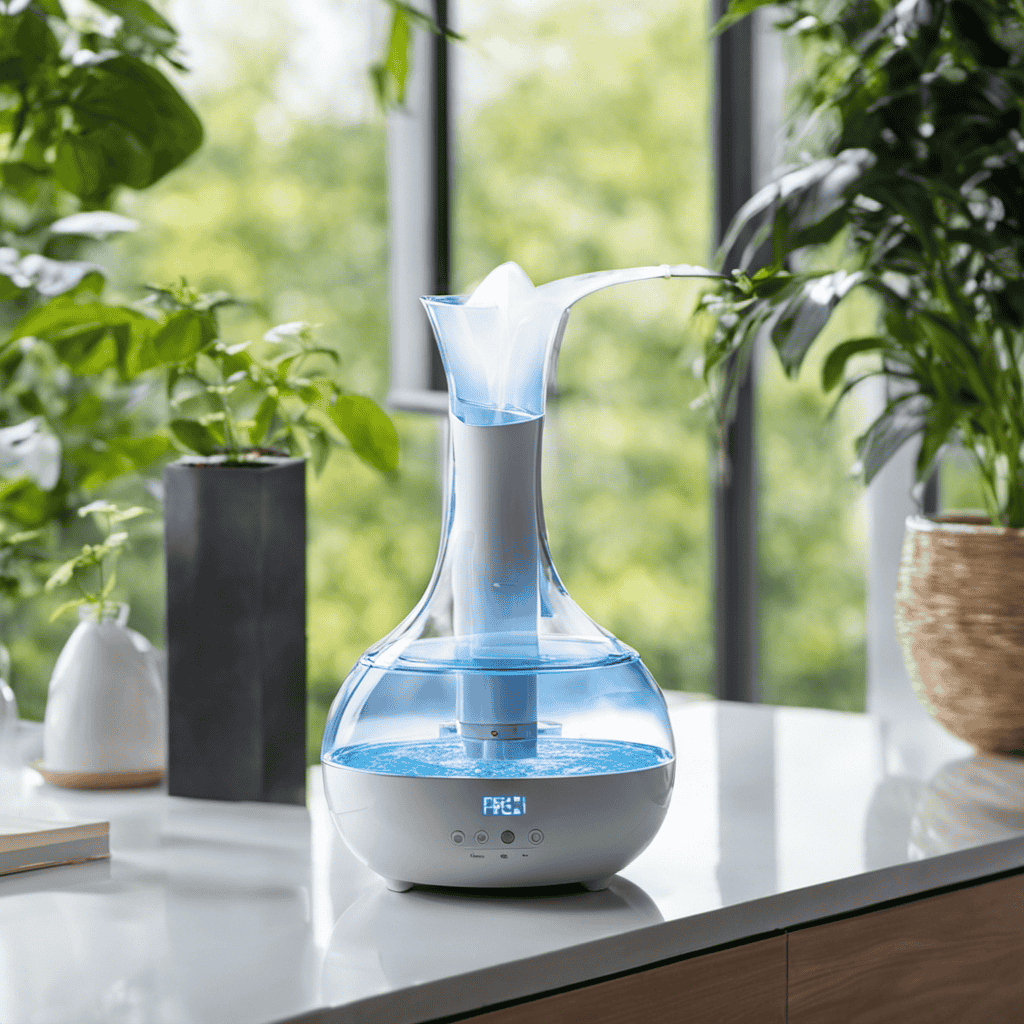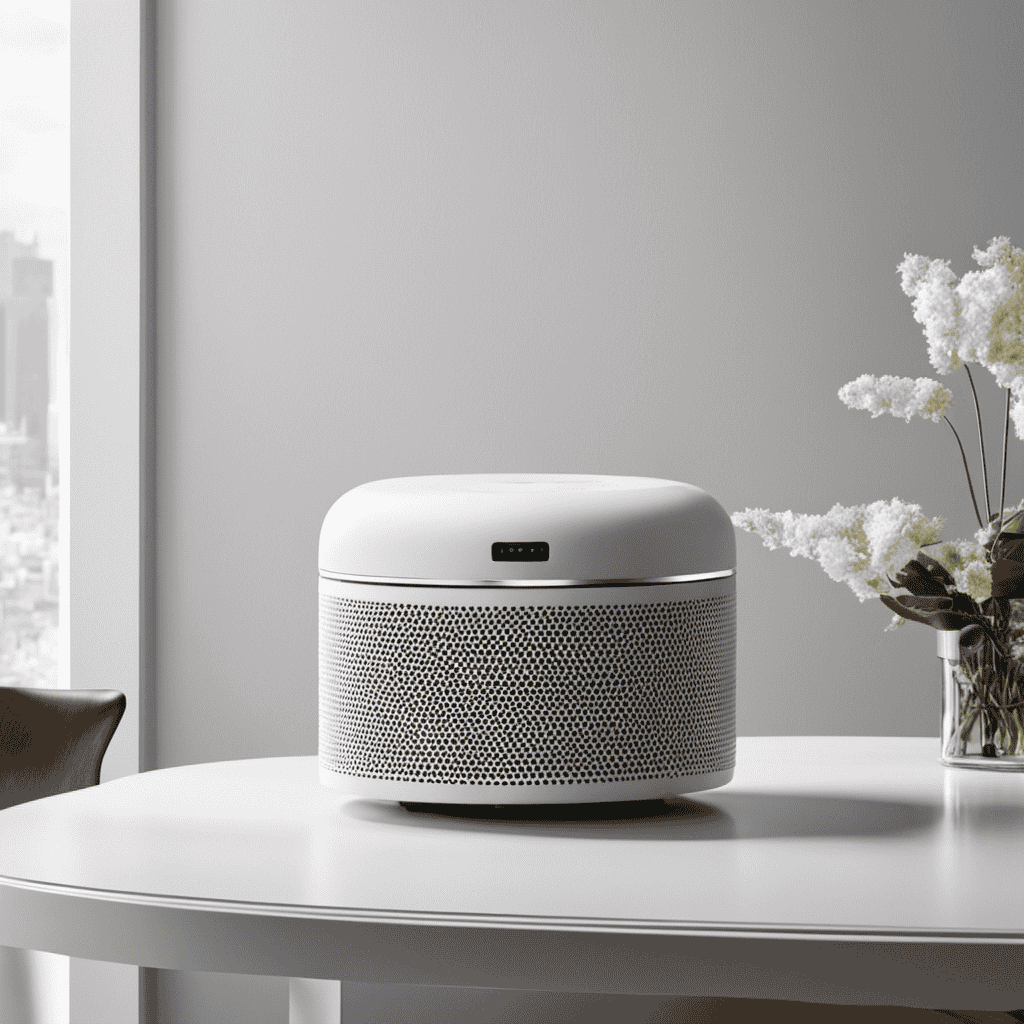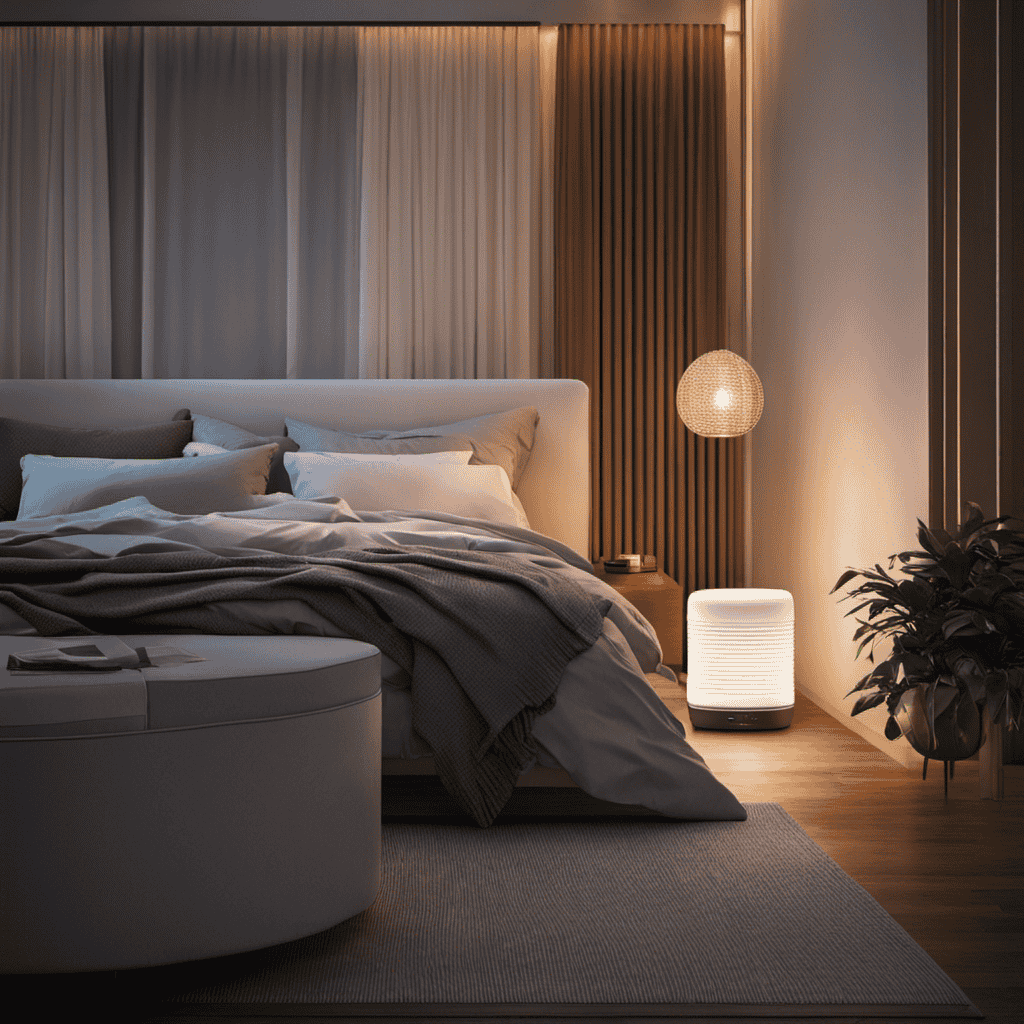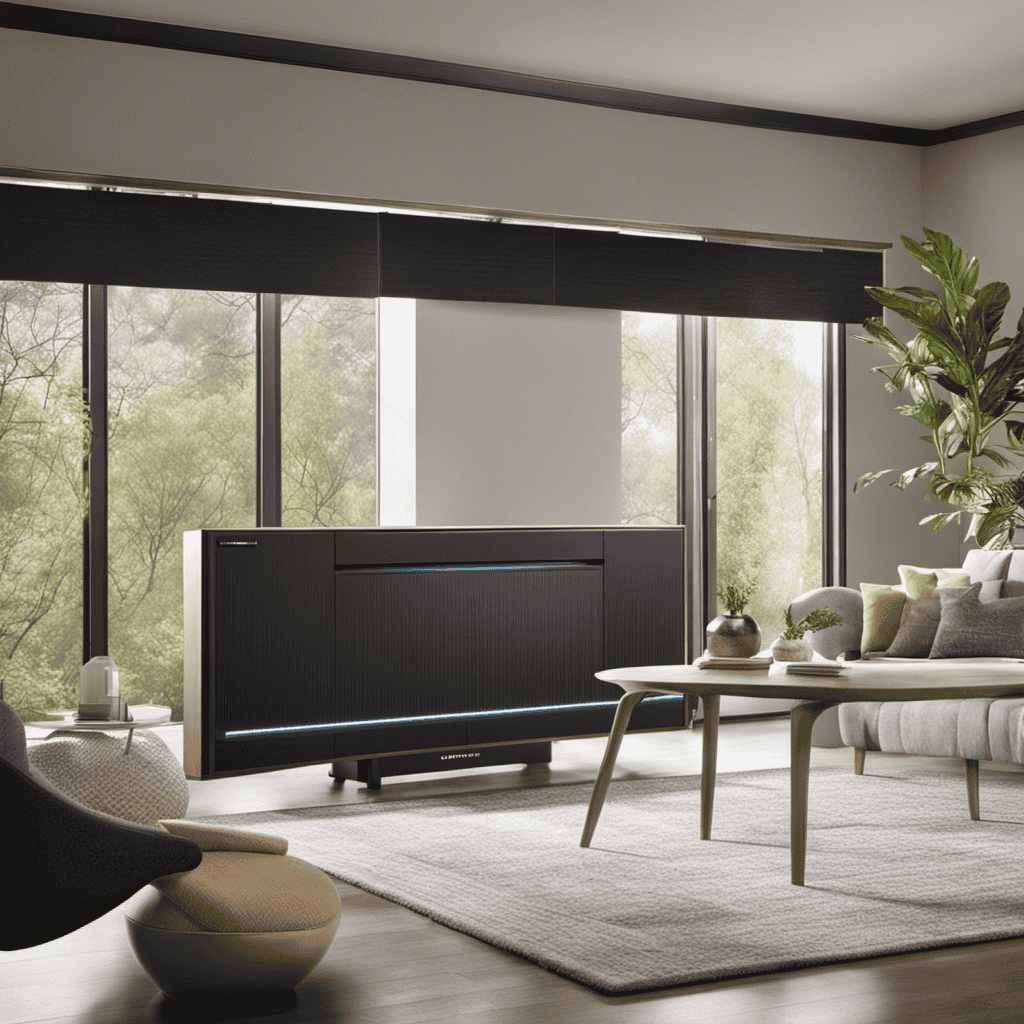As a curious individual intrigued by the interplay between technology and health, I find myself pondering the question: how does an air purifier work to help with smoking cigarettes?
In this article, we will delve into the inner workings of these devices, exploring the various types of air purifiers and their mechanisms for smoke removal.
By understanding the science behind air filtration systems and the role of filters in eliminating smoke particles, we can uncover the benefits of using an air purifier in mitigating the effects of smoking.
There are different types of air purifiers available in the market. When it comes to dealing with smoke particles, it is important to understand the different air purifier technologies and their effectiveness in removing them.
Smoke particles are very small, typically ranging from 0.1 to 1 micron in size. This means that the air purifier needs to have a filtration system that is capable of capturing such small particles.
HEPA (High-Efficiency Particulate Air) filters are commonly used in air purifiers and are highly effective in removing smoke particles. These filters can capture particles as small as 0.3 microns with an efficiency of 99.97%.
Some air purifiers also utilize activated carbon filters, which are effective in removing odors and chemicals associated with smoke.
Understanding the different types of air purifiers and their filtration capabilities is crucial in choosing the right one for effectively removing smoke particles from the air.
Now, let’s dive into understanding air filtration systems in more detail.
The key components of an air purifier are the filters, fan, and control panel. Air purifier technology has advanced significantly in recent years, allowing for more efficient and effective air purification. One of the most important aspects of an air purifier is its ability to circulate air. Air circulation plays a crucial role in removing pollutants and contaminants from the indoor environment. By continuously circulating the air through the filters, an air purifier can capture and remove particles such as dust, pollen, pet dander, and even smoke particles from cigarettes. This is particularly important for individuals who smoke indoors or live in areas with high pollution levels. The table below provides a summary of the key components and their functions in an air purifier:
When it comes to removing smoke from the air, the type of filter used plays a crucial role.
There are different filter types specifically designed to target smoke particles, such as activated carbon filters and HEPA filters with a smoke removal capability.
These filters work by trapping and neutralizing smoke particles, ensuring a cleaner and healthier indoor environment.
However, to maintain the efficiency of smoke removal, regular filter maintenance is necessary to prevent clogging and ensure optimal performance.
Key Takeaways
- Different air purifier technologies are available in the market to help with smoking cigarettes.
- HEPA filters are effective in removing smoke particles, while activated carbon filters can eliminate smoke odors and chemicals.
- Air filtration systems play a crucial role in capturing and eliminating pollutants, ensuring clean air for respiratory health.
- Proper maintenance, including regular filter cleaning or replacement, is essential for optimal performance and air quality.
Types of Air Purifiers
Understanding Air Filtration Systems
To understand how air filtration systems help with cigarette smoke, it is important to know how they effectively remove harmful particles from the air. Air filtration technology plays a crucial role in ensuring clean air. It captures and eliminates various pollutants, including those associated with cigarette smoke. These systems typically consist of multiple layers of filters, each designed to target specific types and sizes of particles. For example, HEPA filters are highly efficient at trapping fine particles such as smoke. Activated carbon filters, on the other hand, are effective at adsorbing odors and chemicals. By utilizing these filtration techniques, air purifiers can significantly reduce the presence of smoke particles in the air. This improves overall air quality and reduces the health risks associated with secondhand smoke. The benefits of clean air cannot be overstated. It promotes better respiratory health and creates a more pleasant and comfortable living environment.Key Components of an Air Purifier
| Component | Function |
|---|---|
| Filters | Capture and remove airborne particles and contaminants |
| Fan | Circulates air through the filters, ensuring efficient purification |
| Control Panel | Allows for easy adjustment of settings and monitoring of air quality |
The Mechanism of Smoke Removal
An air purifier effectively captures and removes smoke particles from the indoor environment by continuously circulating the air through its filters. The mechanism of smoke removal involves multiple stages. Here’s how it works:- Pre-filtration: The air purifier first captures larger smoke particles such as ash and soot through a pre-filter. This helps prevent the particles from entering the main filtration system.
- Activated carbon filtration: Smoke contains numerous harmful chemicals and odors. An activated carbon filter adsorbs these substances, reducing their presence in the air.
- HEPA filtration: The air then passes through a high-efficiency particulate air (HEPA) filter. This filter captures ultrafine smoke particles, including those that are invisible to the naked eye.
The Role of Filters in Removing Smoke
Filter Types for Smoke
To effectively filter smoke from cigarettes, it’s important to consider the different types of filters available for your air purifier. Two commonly used filters for removing smoke particles are carbon filters and HEPA filters. Carbon filters are specifically designed to remove smoke odors and chemicals. They are made of activated carbon, which has a large surface area that can effectively adsorb and trap smoke particles. These filters are highly efficient in eliminating smoke smells, making your indoor air fresher and healthier. On the other hand, HEPA filters are known for their ability to capture small particles, including smoke particles. These filters are made of densely packed fibers that can trap smoke particles as small as 0.3 microns in size. HEPA filters are effective in reducing the amount of smoke in the air and improving indoor air quality. Choosing the right filter for your air purifier can greatly enhance its smoke-filtering capabilities, ensuring that you breathe in cleaner air free from harmful smoke particles.Efficiency of Smoke Removal
The efficiency of smoke removal can vary depending on the type of filter used in your air purifier. There are various smoke elimination methods employed by air purifiers, such as mechanical filtration, activated carbon adsorption, and electrostatic precipitation. Mechanical filtration is the most common method, where a filter captures smoke particles as air passes through it. The effectiveness of this method depends on the filter’s ability to trap small particles. Activated carbon adsorption, on the other hand, uses a porous material to chemically absorb smoke odors and harmful gases. This method is highly effective in removing smoke-related odors. Electrostatic precipitation uses an electric charge to attract and capture smoke particles. While it can be effective, it may not be as efficient as other methods in removing smaller particles. Therefore, when choosing an air purifier for smoke removal, consider the type of filter and its effectiveness in eliminating smoke particles and odors.Maintenance of Filters
Regularly cleaning and replacing your filters is essential for maintaining the efficiency of your air purifier in removing smoke particles and odors. Neglecting filter maintenance can lead to reduced performance and compromised air quality. Here are some maintenance tips to ensure your air purifier works effectively:- Clean or replace the pre-filter: This outer layer traps larger particles like dust and hair, preventing them from clogging the main filter.
- Replace the carbon filter: This specialized filter is designed to absorb smoke particles and odors. Over time, it becomes saturated and loses its effectiveness.
- Clean the HEPA filter: This high-efficiency filter captures tiny smoke particles. Gently vacuuming or washing it can help prolong its lifespan.
Air Purifier Placement for Maximum Effectiveness
Placing an air purifier near the source of cigarette smoke ensures maximum effectiveness. When it comes to air purifiers, there are a few key factors to consider for optimal performance. First, noise reduction is an important consideration. Look for models with low noise levels, as this allows for a more peaceful environment. Secondly, the size and capacity of the air purifier are crucial. A larger unit is better suited for larger rooms or open spaces, while a smaller unit may be more appropriate for smaller areas. It is important to choose a purifier that matches the size of the room for efficient air cleaning.Benefits of Using an Air Purifier for Smoke
Using an air purifier can greatly improve the air quality in your home, especially when dealing with smoke. The effectiveness of an air purifier in removing smoke particles from the air is determined by its smoke removal efficiency. Here are three key benefits of using an air purifier for smoke:- Reduced Health Risks: Smoke contains harmful toxins and chemicals that can be detrimental to our health, especially if we are exposed to it for prolonged periods. An air purifier with high smoke removal efficiency can help eliminate these harmful pollutants, reducing the risk of respiratory problems and other health issues.
- Improved Indoor Environment: Smoke can leave behind an unpleasant odor that lingers in the air and on surfaces. By effectively removing smoke particles, an air purifier can help eliminate these odors, creating a fresher and more pleasant indoor environment.
- Peace of Mind: Knowing that you have a reliable air purifier that can effectively remove smoke particles from your home can provide a sense of peace and reassurance. You can breathe easier, knowing that you are taking proactive steps to improve the air quality and protect your health.
Factors to Consider When Choosing an Air Purifier for Smoke
When choosing an air purifier for smoke, there are several factors to consider. Firstly, you’ll want to think about the size of the room where you plan to use the air purifier. It’s important to choose a purifier that is suitable for the square footage of the room in order to effectively clean the air. Additionally, the effectiveness of the filtration system is crucial. HEPA filters are known for their ability to remove smoke particles from the air, so make sure to choose a purifier that incorporates this type of filter. In terms of air purifier brands, there are several reputable options available. Some popular choices include Honeywell, Coway, and Blueair. Lastly, cost considerations are also important. While it’s tempting to opt for a cheaper model, investing in a high-quality air purifier will ensure better performance and durability in the long run.Maintenance and Cleaning of Air Purifiers
After considering the factors to consider when choosing an air purifier for smoke, it’s important to understand the maintenance and cleaning techniques required to keep the purifier functioning effectively. Regular maintenance ensures that the purifier continues to filter out harmful smoke particles and odors efficiently. Here are some troubleshooting tips and cleaning techniques to ensure optimal performance:- Regularly clean or replace the filters to prevent clogging and maintain air flow.
- Vacuum the exterior and vents to remove dust and debris.
- Use a damp cloth to wipe down the surface of the purifier to remove any residue or buildup.
Tips for Enhancing the Effectiveness of an Air Purifier
Proper filter maintenance is crucial in maximizing the effectiveness of an air purifier. Regularly cleaning or replacing filters ensures that they can efficiently capture and remove pollutants from the air. Additionally, proper placement and ventilation of the air purifier are important factors to consider. Placing the unit in a central location and ensuring adequate airflow can help optimize its performance. Lastly, choosing the right model based on the specific needs and room size is essential for achieving the desired air purification results.Proper Filter Maintenance
To keep your air purifier working effectively, make sure you regularly clean and replace the filters. Proper filter replacement is crucial for maintaining the optimal performance of your air purifier. Neglecting this essential step can lead to common filter problems such as reduced air flow, decreased filtration efficiency, and increased energy consumption. Regularly cleaning the filters will prevent dirt, dust, and other particles from accumulating and clogging the filter, ensuring that the air purifier can effectively capture and remove pollutants from the air. Additionally, replacing the filters according to the manufacturer’s recommendations will help maintain the air purifier’s effectiveness in improving air quality. By following these maintenance guidelines, you can ensure that your air purifier continues to provide clean and fresh air for your indoor environment. Now, let’s discuss the importance of proper placement and ventilation for your air purifier.Placement and Ventilation
In order for an air purifier to effectively remove smoke particles from the air, proper placement and ventilation are crucial. The positioning of the air purifier plays a key role in maximizing its effectiveness. It is recommended to place the purifier in close proximity to the source of smoke, such as near the smoking area or ashtray. This allows the purifier to capture the smoke particles before they disperse throughout the room. Additionally, the airflow direction of the purifier should be considered. Placing the purifier in a spot where the airflow is unobstructed and can circulate freely ensures that the smoke particles are efficiently captured and filtered. By strategically positioning the air purifier and ensuring proper airflow direction, the purification process is optimized, resulting in cleaner and fresher air.| Purifier Placement | Airflow Direction | Effectiveness |
|---|---|---|
| Near smoking area | Unobstructed | Maximized |
| Away from smoking area | Obstructed | Reduced |
| In the center of the room | Unobstructed | Balanced |
| Near an open window | Towards the window | Enhanced |
| In a closed space | Towards the door | Limited |
Choosing the Right Model
When selecting the right model, consider the size and specific needs of your space. Air purifiers come with various features that can help improve indoor air quality, especially when dealing with cigarette smoke. Here are some key factors to consider:- HEPA Filters: These high-efficiency particulate air filters can capture tiny particles, including smoke particles, ensuring cleaner air.
- Carbon Filters: These filters are effective in removing odors and volatile organic compounds (VOCs) commonly found in cigarette smoke.
- Activated Carbon Pre-Filters: These pre-filters can extend the life of the primary filters by capturing larger particles and reducing odor.
Can an Air Purifier Help With Cigarette Smoke-Related Coughing?
Indeed, an air purifier has the ability to aid in preventing coughs with an air purifier by cleansing the air of harmful substances found in cigarette smoke. It can markedly decrease both the smoke levels and the smell in the air, thereby helping to lessen coughing and enhance the air quality inside a house.










